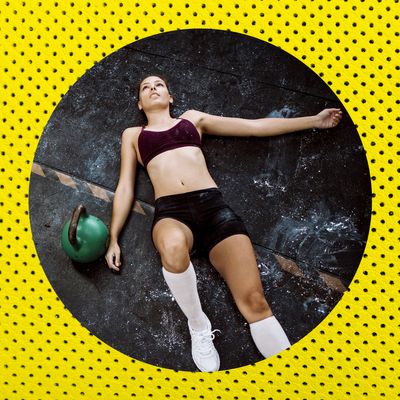
Hot Bod is a weekly exploration of fitness culture and its adjacent oddities.
If slumber has been an elusive state for you this week, same. Same same same. Shocking that the emotional ingredients of “watchful vigilance,” “highly reasonable paranoia,” and “deeply informed confusion” have not been a foolproof recipe for a peaceful eight hours.
Sleeping well is not a choice, unfortunately. It’s not a decision you can make. Sleep is uncertain; sleep is going to do what it wants; sleeping favors the indirect approach. It seems predetermined by some delicate amalgam of daily ingredients: coffee intake, screen time, threats to democracy, etc. This arrangement sets up the biggest, most restless form of frustration: when you did everything you could think of, and you’re still waiting, twitchily, to see if the thing you want the most will happen. Waiting for sleep, waiting for results, waiting for some announcement of new fate: It’s all compounded.
But rifling through my experiences, there is one thing that more reliably queues up instant, luxurious, enthralled sleep in the strange schedule of my body. I hate to admit how wholesome it is, but it’s a long, outdoorsy ramble. The summers I spent running around after campers, I fell asleep immediately each night and took a daily nap. I know that a sleeping bag on rough, cold ground could never be mistaken for comfortable, but when I’ve gone backpacking, I’m never awake long enough to notice. And I have a friend, Victoria, now famous for falling asleep while someone was fixing a flat tire during a long bike ride. She propped her head on a sidewalk curb, making a pillow from concrete, peaceful as a child.
There’s a physiological theory that vigorous, big exercise prompts deep, big sleep because it’s an experiment in opposites. Heightened movement provides the body with a helpful contrast between what it feels like to be alert and in motion, and what it feels like to be at rest, says Dr. Leslie Sherlin, a sports psychologist who studies the brains of elite athletes. “It’s a lot easier to relax your arm after you’ve tensed your arm,” Sherlin says. “After I tried very hard in this one moment, then I can appreciate the absence of effort in the calm, quiet state. It creates a deliberate intentionality of movement.”
Moving fast, outside, for a couple hours if I can swing it, might be my melatonin. Melatonin, meanwhile, is definitely not my melatonin. This is my cue to emphasize, according to sleep experts, that sleep is very personal. There is no universal strategy that will guarantee good sleep. This holds up for melatonin, this holds up for exercise.
So with full respectful acknowledgement to slumber’s finicky spirit, there are a handful of general best practices regarding exercising and sleeping. First, do your vigorous exercise at least four hours before going to bed, when it’s less likely to be disruptive, says Sherlin, and know that anaerobic exercises, like lifting weights, fatigue us more acutely than aerobic, cardio exercise. Also note that feeling more fatigued is not necessarily a recipe for immediate sleep. Counterintuitively, your body might not want exhausting physical drama during the day in order to sleep well that night. It might just want a little shifting around as its exercise in opposites. “Maybe an hour and a half before they go to bed, I like to suggest people do a light exercise, like a 20-minute walk, as part of a bedtime routine,” Sherlin says. “It creates a buffer between whatever crap happened during the day.”
Right now, we have so much crap. If ever there was a time to advocate for a crap buffer, this is the time.
And the buffer might not need to be anything more than one well-selected stretch. In her programming for Alo Moves, yoga instructor Naya Rappaport created a fan-favorite series called “Yoga for Better Sleep.” She also wanted to ritualize this buffer practice and set up movements that were oriented to give the body a break. “If there’s one pose I recommend prior to bed, put your legs up the wall. It’s so chill. This is an inversion that helps the heart and blood flow. It’s also great for a heavy cycle of menstruation.”
So you can move really fast and far from the crap of this week, so fast that afterward, you could fall asleep on a sidewalk. Or you could move just a bit, but resolutely, to put a wall between the piled up nonsense of the day and the recharging of the night. Whatever experiment in contrasts seems right to you, maybe that’s the ticket. I’m trying to walk a lot, quickly under trees with the dog. We’re doing lots of hills and I’m wearing a very interesting sporty-furry jacket I borrowed from my mother, tied around my waist. I’m not self-controlled enough to avoid refreshing election counts as I walk, so it doesn’t feel quite like a break, but it does feel different. No surprise, just “feeling different” is good enough for me right now. If your day seems like an amorphous weighted fog above your crunched shoulders, and then if your movement seems like energetic little bolts of lightning that flail your limbs around, then, maybe, when you’re ready to lie down and turn the light off, you’ll recognize this as a little stretch of peace.

